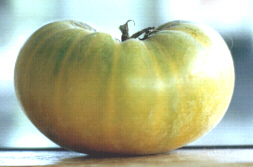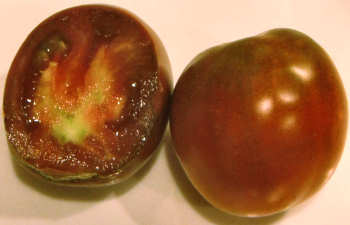Tomato Colors
Tomato colors are kind of tricky; red isn’t the only color in the pallet. If you’ve spent any time with seed catalogs or read any books on tomatoes, you’ll see references to yellow, pink, orange, bicolor, striped, green, purple, chocolate, white and black. And now the pallet includes blue/indigo!
Still, the colors aren’t necessarily obvious. Nor do the same varieties of tomatoes grown in different climates have the same color. What’s a home gardener to do?
Notes on Color
In general, tomato fruit colors are more vivid in warm climates than the cooler climates. While it doesn’t always hold true (many reds, pinks and yellows are bright no matter where), others need warmer weather to color up.
Conversely, tomatoes like the white varieties need cooler weather to retain most of their white/ivory color. Grown in the sunny South, they’ll end up more yellow.
The shades that really need warmth to reveal their depth of color are the purple, chocolate and black tomatoes. If you grow these in the cooler climates, you may be disappointed as to the paleness of the colors of the ripe fruits, compared to what you see online or in catalogs (which tend to be grown in warmer climates).
Tomato Colors
The fruit colors are as follows:
- Red: No real need to explain this, as it’s what you see in the grocery store. Red tomatoes have red interiors and yellow skin.
- Pink: These are tomatoes with a red interior but clear skin; therefore, they appear pinker than the reds.
- Purple: Generally a richer, dusky pink, both skin and flesh.
- White: I have yet to see a white tomato (in my climate anyway) that stays white when ripe. They start out that way, but then develop ivory to light yellow tones. The best chance for a white tomato to stay almost all white is one grown in a cooler climate, and shaded by a lot of leaves.
- Yellow: A clear, lemony yellow, both inside and out.
- Gold: These are the tomatoes that start out as yellow, but turn a richer gold color when ripe.
- Orange: These are really orange-colored, although some are brighter than others.
- Green: The skin is mostly green when ripe, with an amber blush on the blossom end. The interiors tend to be an almost neon green.
- Chocolate: A dusky purple. If you’re not used to darker tomatoes, you might think these look very strange when ripe.
- Black: A much darker purple. Some people are put off by the color of the skin and flesh of a black tomato, but they really are very good!
- Bicolor: Generally these refer to the red and yellow colors. The interiors are usually a swirl of yellow and red — gorgeous when cut in half!
- Striped: Just as you might imagine, the exterior is striped. The interior is usually just one color though. Visually stunning!
- Blue (Indigo): A relatively new color, but not exactly blue. They have a lot of anthocyanin in their skins, and they actually can look rather blue when unripe. Then the blue color turns more of a dark purple as they ripen.
Quite a few choices, wouldn’t you say? As a special note, the more exotic colors are generally heirloom tomatoes. Hybrids tend to be in the red-pink-yellow range, with some orange and white thrown in for good measure. Naturally, there are exceptions (there are quite a few indigo hybrids popping up).
Do the Different Colors Taste Different?
There are no hard-and-fast rules as to correlating tomato color to tomato taste; it really depends on the tomato variety and the growing conditions.
That being said, some people think that:
- Green tomatoes taste “zippier”.
- Yellow, white and orange tomatoes have the reputation of being blander (although not necessarily bland). But there are plenty of them that are very tomatoey tasting!
- Pink and purple tomatoes have the richest tastes and creamiest textures.
- Black and chocolate tomatoes have a deeper taste, less sweet.
- Bicolor and blue/indigo tomatoes are kind of all over the place. Most are just nice.
- Red tomatoes are the most common and range from bland (usually the store-bought ones) to very rich and luscious.
But like I said, it really does depend on the variety you grow. Not all tomatoes of a different color are alike!


Leave a Reply